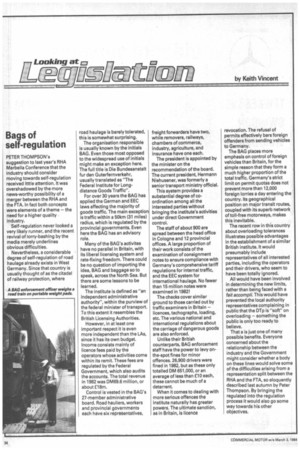Looking at 1=7
Page 38

If you've noticed an error in this article please click here to report it so we can fix it.
(Egpto3mtecoim
by Keith Vincent
Bags of self-regulation
PETER THOMPSON's suggestion to last year's RHA Marbella Conference that the industry should consider moving towards self-regulation received Itttle attention. It was overshadowed by the more news-worthy possibility of a merger between the RHA and the FTA. In fact both concepts were elements of a theme — the need for a higher quality industry.
Self-regulation never looked a very likely runner, and the recent revival of lorry-bashing by the media merely underlines obvious difficulties.
Nevertheless, a considerable degree of self-regulation of road haulage already exists in West Germany. Since that country is usually thought of as the citadel of railway protection, where road haulage is barely tolerated, this is somewhat surprising.
The organisation responsible is usually known by the initials BAG. Even those most opposed to the widespread use of initials might make an exception here. The full title is Die Bundesanstalt fur den Guterfernverkehr, usually translated as "The Federal Institute for Longdistance Goods Traffic".
For over 30 years the BAG has applied the German and EEC laws affecting the majority of goods traffic. The main exception is traffic within a 50km (31 miles) radius, which is regulated by the provincial governments. Even here the BAG has an advisory role.
Many of the BAG's activites have no parallel in Britain, with its liberal licensing system and rate-fixing freedom. There could be no question of importing the idea, BAG and baggage so to speak, across the North Sea. But there are some lessons to be learned.
The institute is defined as "an independent administrative authority", within the purview of the federal minister of transport. To this extent it resembles the British Licensing Authorities.
However, in at least one important respect it is even more independent than the LAs, since it has its own budget. Income consists mainly of licence fees paid by the operators whose activities come within its remit. These fees are regulated by the Federal Government, which also audits the accounts. The total revenue in 1982 was DM69.6 million, or about £18m.
Control is vested in the BAG's 27-member administrative board. Road hauliers, workers and provincial governments each have six representatives, freight forwarders have two, while removers, railways, chambers of commerce, industry, agriculture, and insurance have one each.
The president is appointed by the minister on the recommendation of the board. The current president, Hermann Niehusener, was formerly a senior transport ministry official.
This system provides a substantial degree of coordination among all the interested parties without bringing the institute's activities under direct Government control.
The staff of about 900 are spread between the head office in Cologne and 12 provincial offices. A large proportion of their work consists of the examination of consignment notes to ensure compliance with Germany's comprehensive tariff regulations for internal traffic, and the EEC system for international haulage. No fewer than 15 million notes were examined in 1982!
The checks cover similar ground to those carried out by traffic examiners in Britain — licences, tachographs, loading, etc. The various national and international regulations about the carriage of dangerous goods are also enforced.
Unlike their British counterparts, BAG enforcement staff have the power to levy onthe-spot fines for minor offences. 26,900 drivers were fined in 1982, but as these only totalled D M 651,000, or an average of less than El 0 each, these cannot be much of a deterrent.
When it comes to dealing with more serious offences the institute naturally has greater powers. The ultimate sanction, as in Britain, is licence revocation. The refusal of permits effectively bars foreign offenders from sending vehicles to Germany.
The BAG places more emphasis on control of foreign vehicles than Britain, for the simple reason that they form a much higher proportion of the total traffic. Germany's strict limit on permit quotas does not prevent more than 12,000 foreign lorries a day entering the country. Its geographical position on major transit routes, coupled with its superb network of toll-free motorways, makes this inevitable.
The recent row in this country about overloading tolerances illustrates possible advantages in the establishment of a similar British institute. It would presumably include representatives of all interested parties, including the operators and their drivers, who seem to have been totally ignored.
All would have been involved in determining the new limits, rather than being faced with a fait accompli. This would have prevented the local authority representatives complaining in public that the DTp is "soft" on overloading — something the public is only too ready to believe.
That a is just one of many possible benefits. Everyone concerned about the relationship between the industry and the Government might consider whether a body on these lines would solve some of the difficulties arising from a representation split between the RHA and the ETA, so eloquently described last autumn by Peter Thompson. By bringing the regulated into the regulation process it would also go some way towards his other objectives.


































































































